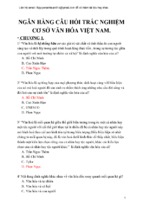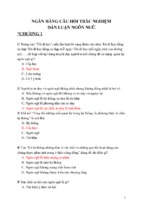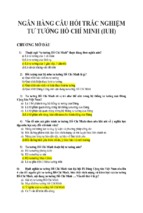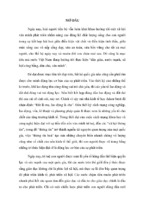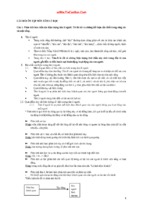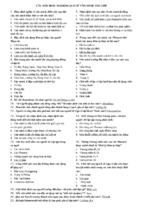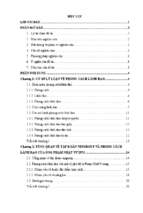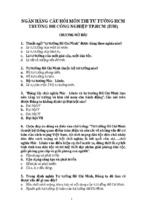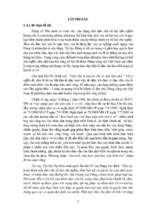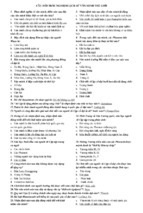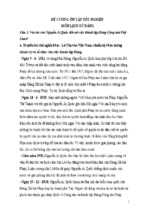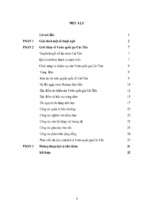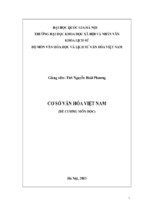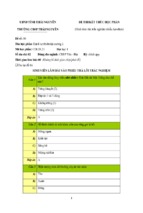MINISTRY OF EDUCATION AND TRAINING
UNIVERSITY OF TRANSPORT AND COMMUNICATIONS
___________________________
HO XUAN BA
DURABILITY ASSESSMENT OF CONCRETE BY
WATER PERMEABILITY AND CHLORIDE DIFFUSION
WITH CONSIDERATION TO THE STRESS FACTOR,
APPLICATION IN BRIDGE STRUCTURE
Disciple: Transport Construction Engineering
Code : 9580205
Major : Bridge and Tunnel Engineering
SUMMARY OF DOCTORAL THESIS
HA NOI - 2020
This thesis was completed at
University of Transport and Communications
Academic supervisors:
1. Prof. Dr. Pham Duy Huu
University of Transport and Communications
2. Assoc. Prof. Dr. Tran The Truyen
University of Transport and Communications
Referee 1: Prof. Dr. Nguyen Thuc Tuyen
Referee 2: Prof.Dr. Nguyen Nhu Khai
Referee 3: Prof.Dr. Nguyen Dong Anh
The thesis will be defended in front of the university-level
doctoral thesis judgement panel at ……………....
At…….., dated ……………………………. 2020
The thesis can be found at
- The Vietnam National Library
- The Library of the University of Transport and Communications
2
INTRODUCTION
1. Imperiousness of topic
The strength of the structure of construction works in general and bridges and tunnels in
particular, reinforced concrete has been a matter of great concern recently in Vietnam. A number
of requirements on the design of structures based on durability have been included in new design
documents, repair designs to maintain the life of the project as expected. Once the durability
requirements are guaranteed, the work will be sustainable over time, the cost of maintenance
and repair of the work will be reduced to a minimum level; project exploitation capacity will be
maximized.
One of the criteria of the durability of structures of reinforced concrete is the durability
of concrete materials against water repellency and chloride ion permeability. In addition to the
study of the application of concrete with good waterproofing ability to apply in practice, the
evaluation of the water permeability, chloride ion permeability through concrete, especially the
studies considering the influence of the effect of load on water permeability and chloride ion
permeability have also been studied in recent times. These include the latest studies of Banthia
&al (2008), A. Antoni & al (2008), Tran & al (2009), H. Wang & al (2011), W. Zhang &al
(2011), G.P. Li & al (2011), A. Djerbi &al (2013), Junjie Wang & al (2015).
The studies of the above authors point out the effects of stress in concrete due to
mechanical impact (load) on water permeability and chloride ion permeability through concrete
through empirical studies or building theoretical model based on Fick or Darcy's law and hollow
structure model of concrete considering the movement of liquid through concrete.
Some points not mentioned in the above studies are empirical studies related to stress
state outside the elastic limit of concrete as well as the relationship between chloride ion
diffusion and water permeability of concrete. If results of these issues are available, it will allow
easy diffusion of chloride ion diffusion (which is difficult to experiment) from water
permeability (easier measurement) of concrete; At the same time, forecasting the effect of the
existence of micro-crack (not yet large cracks) on the service life of reinforced concrete bridges.
In Vietnam, the study of the effect of the load on water permeability and chloride ion
permeability of concrete is still a new issue, not many studies have mentioned it. Partly due to
the complexity of the experiments, the evaluation of water permeability and the diffusion of
chloride ions through concrete, especially those that take into account the effect of direct
compression loading.
The study to evaluate the relationship between water permeability and chloride ion
diffusion with consideration of stress factors in concrete is necessary, with many meanings for
the assessment and forecast of the life of the building; suitable with the exploitation
characteristics of constructions in general and bridges in particular, especially bridges in
Vietnam.
From the urgent requirements and the important implications in proposing a model to
assess the effect of load on the permeability of concrete and its application in predicting the life
of a building with reinforced concrete in general and the bridge works in particular, the research
topic " Assessment durability of water permeability and chloride ion of concrete with
consideration to the stress factor, application in bridge structures " was selected as the thesis
topic.
The thesis content consists of 4 chapters, introduction, conclusion and recommendation
+ Introduction
+ Chapter 1: Overview of concrete durability and studies related to water permeability,
chloride ion diffusion of concrete.
1
+ Chapter 2: Experimental analysis of water permeability of concrete considering to the
state of compressive stress.
+ Chapter 3: The chloride diffusion analysis test of concrete considering to the state of
compressive stress.
+ Chapter 4: Calculation the durability of reinforced concrete bridge construction with
consideration to the simultaneous effect of load effect and environmental impact
+ Conclusion and recommendation
2. Objective of Thesis
The objectives of the thesis are:
+ Determine the coefficient of water permeability, waterproofing marks, chloride ion
diffusion coefficients of some types of concrete commonly used in bridge construction
subjected to pre-compressive and direct-compression loads.
+ Establish a relationship between the coefficient of water permeability and the chloride
ion diffusion coefficient, taking into account the effect of direct compression load.
+ Develop a predictive model for life expectancy using reinforced concrete bridges
taking into consideration the effect of the load according to the criteria of initial
corrosion of reinforcement in concrete. Application of life expectancy for the structure
of reinforced concrete bridges.
3. Object and Scope of Research
3.1. Object of Research
The object of research is some types of concrete commonly used in bridge construction.
The coefficient of water permeability, chloride ion permeability and the correlation between
them considering the effect of load. Service life of reinforced concrete structure bridges.
3.2. Scope of Research
+ Reinforced concrete structure with compressive stress in aggressive environments with
chloride ions..
+ Concrete in construction works in general and bridges in particular..
4. Research method
+ Methods of synthesis, analysis and comparison..
+ Research methods are mainly theoretical and experimental methods. Use advanced
theories of durability of concrete to identify experimental correlations (formulas) and
conduct empirical research to verify.
+ Modeling to predict the service life of reinforced concrete bridges affected by chloride
ion diffusion taking into account the effect of the load.
5. New Contributions of Thesis
+ The values of water permeability coefficient, waterproofing marks, chloride ion
diffusion coefficient of some types of concrete commonly used in bridge construction
are subject to pre-compressive load and direct compression load.
+ The relationship between water permeability and chloride ion diffusion coefficient,
taking into account the effect of direct compression load.
+ Predictive models for longevity using reinforced concrete bridges take into account the
effect of the load according to the criteria of initial corrosion of reinforcement in
concrete. Application of forecast life expectancy structure of reinforced concrete
bridges.
2
CHAPTER 1: OVERVIEW OF CONCRETE DURABILITY AND STUDIES
RELATED TO WATER PERMEABILITY, CHLORIDE ION DIFFUSION OF
CONCRETE
Overview of durability of concrete
The durability of cement concrete according to ACI 201.2R-08 [1] defines "Resistance to
weathering, chemical corrosion, abrasion, or any other degradation process", meaning Is durable
concrete that retains its original appearance, quality, and serviceability when exposed to the
environment.
The deterioration of reinforced concrete structure when exposed to the environment has
many mechanisms. In the scope of the research in this thesis, along with the conditions and
characteristics of Vietnam's climate, especially in coastal areas, the mechanism leading to the
decline is mainly assessed through the criteria of durability such as the waterproofing ability of
liquids and the resistance to diffuse chloride ions through concrete. In addition, carbonation,
sulfate corrosion, acidic and seawater corrosion can be included.
The waterproofing of concrete, a hollow material, is highly dependent on parameters of the
concrete environment such as porosity, zigzagness of voids and interconnection between voids.
Scrivener [2] said that, when the porosity and the gap between pores in concrete increases, the
waterproofing strength of concrete is reduced; and the more straight the pores are, the faster the
flow of permeation flows. Under mechanical actions such as creep, shrinkage, or temperature,
..., will lead to destruction in concrete accompanied by cracks that increase the above
parameters, permeability of concrete so also will increase rapidly. The permeability diagram is
illustrated in Figure 1.1
Figure 1.1 - Effect of porosity, form, size of hollow lines and interconnection of porosity on
permeability of concrete (Scrivener (2001) [2])
Corrosion of reinforcement in concrete is a common problem affecting the durability of
reinforced concrete structures. In particular, the corrosion caused by chloride ions is one of the
main causes leading to the decline, affecting the long-term durability of structural structures [3].
As long as the reinforcement is still surrounded by dense protective layers of concrete, the
alkaline environment in the concrete is high enough to create a protective film on the
reinforcement. If this protective film is destroyed, reinforcement corrosion will occur, resulting
in a reduction of cross-sectional area and bearing capacity of reinforced concrete structural
parts.
The process of carbonation of concrete under the effect of CO2 in the environment by
reaction:
Ca(OH)2 + CO2 = CaCO3 + H2O
(1.1)
This process takes place from outside to inside of concrete, over time. However, in order
for the carbonation process to take place completely (then the pH of concrete is only about 9)
even if the thickness of the protective layer is thin, it needs a long time (20 ÷ 30 years or more).
3
On the other hand, the results of many practical studies prove that even concrete structures have
very high pH (greater than 11.5) but corrosion still occurs.
The cause of chloride ion concentration, which exceeds the limit, destabilizes the passive
membrane layer:
Chloride ions are present in concrete for the following reasons: Concrete structures working
in marine environment or other chloride-containing environments, concrete made from salty
materials, when treating concrete thawing agents or when using rapid solid additives containing
chloride ions,...
The study of the water permeability and diffusion of chloride ions of concrete in the
world.
Water permeability of concrete is always an important issue for concrete structures in
contact with water because water permeability affects the durability of reinforced concrete
structures. Water permeability through concrete is a cause of reinforced corrosion in concrete
when the structure of the project is exposed to corrosive water environment such as
groundwater, mineral water, seawater, domestic wastewater and industrial contains corrosive
agents. In addition, much infiltrated concrete will lose water in reservoirs, canals, water tanks,
causing roof leakages, standing water,...
According to Banthia N. et al. [4] the permeability of concrete is influenced by two main
factors: One is the porosity characteristics such as size, zigzagness, and the connection between
voids, Two is Micro crack in concrete, especially at the bonding surface between aggregate and
binder. The porosity factor is controlled mainly by the N / X ratio, the degree of hydration and the
degree of compaction. Meanwhile, the density and location of micro-cracks at the bonding surface
are determined by the effective stress level, appearing inside or outside the structure of concrete Stress
occurs inside the concrete due to shrinkage, temperature difference, sudden change of heat-moisture
in the environment and factors that cause volumetric instability.
The effect of stresses due to external influences on concrete permeability is still poorly
understood. Questions such as the degree of stress, at what age of concrete are acceptable
when assessing permeability need to be clarified.
Figure 1.2 - Effect of capillary voids on permeability
(Powers (1958))
Water permeability of concrete under load.
Researchs on the effect of load on the water permeability of concrete have been published
by a number of authors in the world such as Kermani (1991) [5], Gerard (1996) [6], Lion & al.
(2005) [7], Banthia & al (2008) [8], Tran & al (2009) [9]. However, these results are quite
dispersed, partly because the water permeability of the concrete is affected by the preparation
of test samples (sample form, concrete composition, aggregate aggregate, conditions of curing,
etc.). and testing process (loading process, pressure of water used ...); On the other hand, the
4
water permeability measurements of concrete obtained are lower than the actual permeability
values due to the chemical and physical reactions of water with the micro structure of concrete.
It is these physico-chemical reactions that make it harder to assess the water penetration
mechanism of concrete and also make the water permeability measurement results lower than
the air permeability measurement results.
In 2009, in his doctoral thesis at Liege University, Tran [10] showed that the water
permeability of concrete depends significantly on the residual effect of pre-compressive load
and water pressure during the experiment. Water pressure is too small or too large, causing the
effect of preventing water permeation through concrete. The occurrence of mechanical damage
due to the applied load has an effect on the increase in the water permeability of concrete similar
to that of air permeability. Water permeability of concrete is approximately 100 times smaller
than air permeability. When concrete is not under the initial water permeability K0 can be
approximated to be 10-19 m2 or 10-11 cm / s. An increase in water permeability has also begun
to be noted when σ/σmax > 0.4 – 0.6
Stanish, K. (2000) [11] developed a relationship between the diffusion coefficient D28 and
the N / X ratio for standardized concrete at 20 ° C. Based on the large database of diffusion
experiments, he proposed empirical relations as follows:
D28 = 1×10(−12,06+2,4 N / X ) (m2/s)
(1.2)
Diffusion coefficient, D28
This relationship is shown in Figure 1.3.
N/X
Diffusion coefficient, CDC (x 10 -8cm2/s)
Figure 1.3 - Relationship between N / X ratio and chloride ion diffusion
coefficient
(Stanish, K. (2000))
Ahmad S., (2003) [12] on the equation expressing the relationship between chloride ion
diffusion coefficient and electric quantity of concrete. This correlation is used to determine
chloride ion diffusion coefficients when chloride ion diffusion levels are known (Figure 1.4).
Permeability level, RCP (coulombs)
Figure 1.4 - Relationship between permeability level and chloride ion
diffusion coefficient
5
(Ahmad S.( 2003))
The formula for calculating the chloride ion diffusion coefficient is as follows:
Normal concrete:
D = 0,0056Q0 - 8,45 ;
(1.3)
Concrete uses silicon soot:
D = 0,0005Q0 + 0,99 ;
(1.4)
Concrete uses fly ash:
D = 0,0019Q0 - 0,86 ;
(1.5)
With:
D: Chloride ion diffusion coefficient of concrete (x10-8 cm2/s);
Q0: Chloride ion diffusion level (Coulombs).
Berke et al. (1992) [13] proposed a correlation between diffusion coefficients and the
amount of coulombs transferred in the experiment.
(1.6)
D = 0,0103 × 10
× (Q ) ,
Q0 is the electric quantity transmitted over 6 hours according to the ASTM C1202
experiment.
d. Formula for the relationship between diffusion coefficient and compressive strength of
concrete.
C. Lim et al. (2000) [14] performed an assessment of the effects of microcracks and chloride
ion diffusion of concrete when subjected to a pre-compressive load one axle. He commented
that, when concrete samples are completely unloaded at a pre-compression load level of 0.5f’c,
the areas where micro-cracks appear can recover 100% to their original state. However, when
unloading at a payload level from 0.7 to 0.95f’c, some crack areas are unlikely to recover after
unloading. This property has a great significance to the permeability of concrete. Chloride ion
diffusion of concrete (after unloading) is affected by the appearance of pre-compressive stress.
The chloride ion diffusion in concrete samples does not change significantly when the precompression load levels are small σ/σmax ≤ 0.7. The increasing degree of permeability can be
seen clearly when the pre-compressive load levels are large σ/σmax > 0.7 as shown in Figure 1.5.
The "ab" line shows that chloride permeability does not change from its original permeability. After
that, the "bc" line after threshold σ/σmax = 0.7 shows the chloride permeability increased rapidly .
Figure 1.5 - Fast chloride ion permeability at various pre-compression load
levels (C. Lim (2000))
In 2013, A. Djerbi Tegguer et al. [15] conducted experiments, evaluated the effect of
uniaxial compressive load on air permeability and chloride ion diffusion coefficient of concrete
and showed the relationship of them. The correlation between air permeability and chloride ion
diffusion coefficients is established by introducing a destructive variable due to the deterioration
of the damaged concrete under the effect of uniaxial compressive load. Common concrete (OC)
and high strength concrete (HPC) samples were used in the experiment to examine the effect of
6
the mechanism of the appearance and spread of cracks in concrete to the air permeability and
chloride ion permeability of the concrete.
Figure 1.6 - The relationship between the relative chloride diffusion coefficient and the
damage value d of concrete (A. Djerbi Tegguer (2013))
Researches on corrosion initiation time and corrosion propagation time, service life.
In 1980, at the international conference on concrete in the marine environment organized
by the American Concrete Institute (ACI), Tuuti [16] suggested that the reinforced concrete
structures working in the marine environment will be ionized: Chloride diffuses into concrete
and accumulates on the reinforced surface. When the chloride ion concentration at the
reinforcement surface reaches the critical concentration threshold, it will begin to cause
reinforcement corrosion. Corrosion of the reinforced steel will have two consequences. Firstly,
it reduces the cross-sectional area of rebar leading to reduced resistance to loads. Secondly,
corroded reinforcement will produce corrosive products, volumetric corrosive products cause
tensile stress in the protective concrete layer and cause concrete cracking, splitting and rupture.
Modeling the service life forecast of reinforced concrete structures due to chloride ion
diffusion needs to show the processes leading to steel corrosion in concrete caused by chloride
ions. These processes are basically described as follows:
- Chloride ions in the environment accumulate on concrete surfaces..
- Chloride ions are diffused into concrete through a number of mechanisms, mainly
diffusion.
- The concentration of chloride ions accumulates over time at the surface of the
reinforcement..
- When the chloride ion concentration at the reinforcement surface reaches the critical
threshold, the passive membrane on the reinforcement surface is broken and corrosion
begins..
- The product of corrosion has a larger volume than the reinforced steel has been corroded,
causing tensile stress in the protective concrete layer..
- Concrete has poor tensile strength, so cracks will appear either perpendicular or
horizontally forming a layer between the reinforcement.
- Cracks forming cracks or breaks making the structure degraded as the use function is no
longer guaranteed or unsafe. This may be the time that repairs are required.
- Corrosion causes loss of steel cross-sectional area, resulting in a state of load-bearing
limit which is no longer satisfied.
Tuutti, K. proposed a two-stage model of service life of reinforced concrete structures as
shown in Figure 1.7. Accordingly, the service life consists of two successive stages: the initial
corrosion stage and the corrosion propagation stage according to Equation 1.7.
(1.7)
t=t +t ;
With:
7
- t is the lifespan used;
- t1 is the beginning of corrosion;
- t2 is the stage of corrosion propagation.
Figure 1.7 - Service life of reinforced concrete structures: Tuuti's two-stage model (1980)
Conclusion of chapter 1
The evaluation of durability and long-term prediction of transport works by reinforced
concrete plays an important role in the management and operation of the system. The evidence
is that this issue has been of interest and research for a long time in developed countries around
the world.
In particular, the two main factors affecting durability are permeability and diffusion of
concrete. In addition, carbonation, chemical corrosion due to acid and seawater can also be
mentioned.
Through many researches on water permeability of concrete, it has been shown that the
permeability of concrete is influenced by two main factors: One is the porosity characteristic;
such as size, zigzagness, and the connection between pores, the two are micro cracks in concrete,
especially at the bonding surface between aggregate and binder. In particular, the effect of
stresses due to external influences on concrete permeability remains unclear. Experiments to
measure water permeability of concrete are classified as follows: steady water flow test,
unstable water flow test, water immersion test.
Meanwhile, for reinforced concrete construction works in the marine environment, the
important damage phenomenon that needs to be considered is the corrosion of steel
reinforcement in concrete due to chloride ions. Many studies have proposed the relationship
between the chloride ion diffusion coefficient of concrete, the water / cement ratio, the time, the
number of Coulombs. In addition, researches to evaluate the effect of pre-stressed state in
concrete have been conducted. Ion diffusion experiments through concrete include stable state
diffusion experiments, unstable state diffusion experiments, electric field migration test. In
general, the implementation of chloride ion permeability tests is complex (especially
considering stress states in concrete). Therefore, indirect determination of chloride ion diffusion
coefficient through simpler experiments such as water permeability test is important in the
evaluation of durability and durability of reinforced concrete structure.
CHAPTER 2: EXPERIMENTAL ANALYSIS OF WATER PERMEABILITY OF
CONCRETE CONSIDERING TO THE STATE OF COMPRESSIVE STRESS
2.1. Introduction
The purpose of the experiments in this chapter is to assess the water permeability of some
typical concrete types commonly used in bridge constructions in Vietnam. Two types of
concrete with 30 MPa (symbol C30) and 40 MPa (symbol C40) respectively were used in these
8
waterproof
marks W
experiments. Experimental program includes the following experiments:
- Experiment to determine compressive strength of concrete.
- Experiment to determine of water permeability of concrete under stress.
- Experiment to determine water permeability of concrete under direct compression stress.
This chapter is structured into 3 main parts. The first part of the chapter deals with the
preparation of test samples, including the preparation of materials, casting and maintenance of
test samples. The second part presents the process of carrying out the test to determine
compressive strength and the test to determine the water permeability of concrete subject to precompression stress and direct compression stress. The third part is the analysis and evaluation
of the experimental results obtained.
In order to design graded concrete with compressive strength fc '= 30 MPa (C30) and fc' = 40
MPa (C40), the post-graduate used Bim Son cement - PC 40 (meeting the requirements of TCVN
2682: 2009).
v Fine aggregate (sand)
Sand used to make concrete is natural sand with a grain size of 0.14 to 5mm - according to
TCVN 7570-2008; from 0.075 to 4.75 mm - according to American standards and from 0.08 to
5mm according to French standards.
The sand used in this research is Da river sand.
v Coarse aggregate (Crushed stone)
Use Hoa Binh Crushed stone.
Stone materials for making concrete must have adequate intensity and wear. Macadam has
good roughness, closely associated with cement mortar, so the flexural strength of macadam
concrete is higher than gravel concrete.
v Water
Use domestic water to produce and maintain concrete. Water must be clean according to
TCVN 4056: 2012 Water for concrete and mortar - Technical requirements.
2.2.Results of water permeability test with concrete samples subjected to precompressive stress
Based on the results of the above experiments, we construct a chart of waterproofing of
concrete C30 and C40 when considering the following compressive stresses (Figure 2.1):
15
C…
10
5
0
0
0.2
0.4max
σ/σ
0.6
0.8
Figure 2.1 – Relationship between waterproof marks of concrete C30 and
C40 according to the pre-compressive stress
When the relative pre-compressive stress is small σ/σmax ≤ 0.3, the increase in water
permeability is quite slow. When the relative stress is greater σ/σmax > 0.5, the water
permeability increases very quickly. The appearance of cracks destroying concrete has made
the process of water penetration increase faster.
In Figure 2.2 and Figure 2.3 we first see that the water permeability of the concrete is almost
unchanged or changes slowly when the relative stress value σ/σmax < 0.4; After this threshold,
the permeability coefficient begins to increase rapidly. When the stress is relative σ/σmax ≥ 0.6,
the water permeability increases very quickly; this can be explained by the micro-structure of
9
concrete being destroyed after this stress threshold - which is the threshold for the occurrence
of dispersed destruction zones (according to the approach of concrete destruction mechanics) –
making increase water permeability of concrete. The rule of increasing water permeability of
concrete after 28 days of age in this experiment is similar to the rule of increasing water
permeability of premature concrete published by Banthia & al (2005) when mechanical damage
has not been appears in concrete.
3E-09
water permeability
coefficient(m/s)
2.5E-09
K5at
m
2E-09
1.5E-09
1E-09
5E-10
0
0
0.2
0.4 σ/σ
0.6
0.8
Relative
stress
max
Figure 2.2 – Relationship between water permeability coefficient of concrete K (m / s) and
direct compressive stress in concrete (Concrete C30 according to different water pressure
levels).
3.00E-09
Water permeability
coefficient (m/s)
2.50E-09
2.00E-09
1.50E-09
1.00E-09
K5atm
5.00E-10
K4atm
0.00E+00
K3atm
0
0.2
0.4
0.6
0.8
Relative stress σ/σmax
Figure 2.3 – Relationship between water permeability coefficient of concrete K (m / s) and
direct compressive stress in concrete (Concrete C40 according to different water pressure
levels).
2.3. Conclusion of chapter 2
In chapter 2, the author conducts experiments, analyzes water permeability through concrete
taking into account the compressive stress factor. Two grades of concrete were chosen, namely
f’c = 30MPa and f’c = 40MPa.
Experimental results to determine the waterproofing of concrete under stress precompression showed that, when the relatively pre-compressive stress is small σ/σmax ≤ 0.3, the
water permeability is quite slow. When the relative stress is greater σ/σmax > 0.5, the water
permeability increases very quickly. The appearance of cracks destroying concrete has
increased the water permeability faster. For C40 concrete samples, the rate of deterioration of
waterproofing marks when pre-compressive stresses in concrete increases, is lower than that of
10
C30 concrete samples.
Results of the water permeability test of directly stressed concrete show that the water
permeability of the concrete is almost unchanged or changes slowly when the relative stress
value σ/σmax < 0.4; After this threshold, the permeability coefficient begins to increase rapidly,
which can be explained by the micro structure of concrete being destroyed after this stress
threshold - the threshold that causes the occurrence of dispersed destruction zones (according
to approach of mechanical destruction of concrete) - increases the water permeability of
concrete.
CHAPTER 3: THE CHLORIDE DIFFUSION ANALYSIS TEST OF CONCRETE
CONSIDERING TO THE STATE OF COMPRESSIVE STRESS
3.1. Introductions
The purpose of the experiments in this chapter is to evaluate the chloride diffusion of some
typical concrete commonly used in bridge constructions in Vietnam. Two types of concrete with
expected strength of 30 MPa (symbol C30) and 40 MPa (symbol C40), respectively, are
considered in these experiments as in the case of water penetration. Experimental program
includes the following experiments:
- Experiment to determine the chloride diffusion of concrete subjected to pre-stressed
stress..
- Experiment to determine of chloride diffusion in concrete subjected to direct
compression.
This chapter is structured into 3 main parts. The first part of the chapter is chloride ion
permeability test with pre-stressed concrete samples including testing principles, material
preparation, molding and curing samples, conducting experiments, building the relationship
between diffusion chloride ions with prestressed state of concrete. The second part presents the
procedure for performing chloride ion permeability testing with concrete samples subjected to
direct compressive stress including the same content as in part 1. The final part is to propose the
relationship between water permeability coefficient and chloride ion diffusion coefficient of
concrete.
3.2. Effect of pre-compressive stress on chloride permeability of concrete
Based on the above experimental results, draw a graph of the relationship between diffusion of
chloride ions of concrete C30 and C40 when reaching the pre-compressive stress as shown in
Figures 3.1 and 3.2.
Diffusion of chloride ions of concrete C30
Electric
quantity(Coulombs)
4500
4000
3500
3000
2500
2000
0
0.1
0.2
0.3
0.4
0.5
0.6
0.7
0.8
σ/σmax
Figure 3.1 - Relationship between electric quantity and pre-compressive stress in concrete
C30
11
Diffusion of chloride ions of concrete C40
Electric
quantity(Coulombs)
3500
3000
2500
2000
1500
1000
0
0.1
0.2
0.3
0.4 0.5 0.6 0.7 0.8
σ/σmax
Figure 3.2 - Relationship between electric quantity and pre-compressive stress in concrete C40
Figure 3.1 and Figure 3.2 show that with two types of concrete considered C30 and C40,
the chloride ion diffusion (through electric quantities) increases linearly and fairly evenly.
Constructing the relationship of increasing chloride diffusion coefficient through concrete (relative
value D / D0) and pre-compressive stress as shown in Figure 3.3, Figure 3.4 and Figure 3.5.
Concrete C30
1.6
y = 0.4851x + 1.0205
R² = 0.9799
D/D0
1.4
1.2
y = 1.0242e0.4081x
R² = 0.9642
1.0
0.8
0
0.2
0.4 σ/σ 0.6
0.8
1
max
Figure 3.3 – Relationship between the relative ratio of chloride ion diffusion coefficient
through concrete and the pre-compressive stress of concrete sample C30. (DO is initial
chloride permeability coefficient).
D/Do
Concrete C40
,1.6
,1.5
,1.4
,1.3
,1.2
,1.1
,1.0
,0.9
,0.8
y = 0.5504x + 1.028
R² = 0.9725
y = 1.0317e0.4537x
R² = 0.9521
0
0.2
0.4
0.6
σ/σmax
0.8
1
Figure 3.4 – Relationship between relative ratio of chloride ion diffusion
coefficient through concrete and pre-compressive stress of concrete
sample C40
12
The results from Figures 3.4 and 3.5 show that for C30 concrete, when the pre-compressive
stress reaches 0.8σmax, the permeability coefficient increases by 1.4 times higher than the
permeability of unloaded concrete.
Concrete C30, C40
1.5
1.4
1.3
1.2
1.1
1.0
0.9
0.8
D/D0
y = 0.5177x + 1.0242
R² = 0.9603
y = 1.028e0.4309x
R² = 0.9455
0
0.2
0.4
σ/σmax
0.6
0.8
1
Figure 3.5 – Relationship between relative ratio of chloride ion diffusion
coefficient through concrete with pre-compressive stress of both C30 and
C40 concrete types
The law of increasing chloride ion permeability coefficient according to the precompressive stress of both C30 and C40 concrete is expressed by the following formulas:
+ Exponential regression: D/Do = 1.028exp(0.4309σ/σmax)
(3.1)
+ Linear regression: D/D0 = 0.5177(σ/σmax) + 1.0242
(3.2)
The above regression lines also show that the rule of increasing diffusion of chloride ions
of concrete is quite similar to the rule of increasing air permeability through concrete subject
to pre-compressive stress. ((A. Djerbi Tegguer – 2013, Choinska – 2008, Tran - 2009) [15],
[17], [10].
3.3. Effect of direct compressive stress on chloride permeability of concrete
The relationship of chloride ion diffusion (C) of C30 and C40 concrete according to the
rapid permeability test corresponding to stress values when compressing simultaneously
concrete samples is shown in Figure 3.6 and Figure 3.7. Experimental results show that chloride
diffusion differs drastically in the presence of simultaneous action loads. However, before and
after diffusion load of chloride ions are in the "average" level according to TCVN 9337-2012.
At a stress level of 30% σmax, the average chloride ion diffusion decreased by 11.33%. When
increasing the stress to 50% and 70% σmax, the permeability of concrete increases by 13.60%
and 35.79%, respectively. The loss of permeability at the stress level of 30% σmax is explained
by the stress causing micro deformation and because the stress is still within the elastic limit,
so no crack has been generated, which in turn increases the concentrates and reduces voids of
concrete thus reducing permeability. In the case of chloride ion diffusion decreases, it will
lead to prolong the time of chloride ion diffusion through protective concrete layer to cause
corrosion of reinforcement in reinforced concrete constructions. From this result it is shown
13
that in a pre-stressed concrete structure, when the compressive stress in the concrete is within
the appropriate limits, it can prolong the diffusion time and increase the life due to chloride
ion diffusion process.
Concrete C30
1.40
1.30
1.20
y = 1.3985x2 - 0.5661x + 0.9898
R² = 0.8484
D/Do
1.10
1.00
0.90
Giá trị…
0.80
0.70
0.0
0.2
0.4
σ/σmax
0.6
0.8
Figure 3.6 – Relationship between relative ratio of chloride ion diffusion coefficient through
concrete and direct compressive stress of concrete C30
Concrete C40
1.40
1.30
1.20
y = 1.2354x2 - 0.5297x + 0.9929
R² = 0.8453
D/Do
1.10
1.00
0.90
Giá trị đo
0.80
0.70
0.0
0.2
0.4
0.6
0.8
σ/σmax
Figure 3.7 – Relationship between relative ratio of chloride ion diffusion coefficient through
concrete with direct compressive stress of concrete C40
3.4. Xây dựng mối quan hệ giữa hệ số khuếch tán ion clorua với trạng thái ứng suất nén trực
tiếp của bê tông
Mối quan hệ giữa hệ số khuếch tán ion clorua của bê tông với điện lượng đo được, được
tính theo công thức của Berke và Hicks
Kết quả tính hệ số khuếch tán ion clorua cho mẫu bê tông thí nghiệm C30 và C40 được
trình bày ở hình 3.3 và 3.4.
Từ kết quả đã tính toán tiến hành xây dựng mối quan hệ giữa hệ số khuếch tán ion clorua
qua bê tông và ứng suất nén trực tiếp của cả 2 mẫu bê tông C30, B40
14
Diffusion coefficient
Dx10-12 (m2/s)
D/Do
Bê tông C30, C40
1.40
1.30
y = 1.317x2 - 0.5479x + 0.9914
1.20
R² = 0.8367
1.10
1.00
0.90
Giá trị…
0.80
0.70
0.0
0.2
0.4
0.6
0.8
σ/σmax
Figure 3.8 – Relationship between relative ratio of chloride ion diffusion coefficient through
concrete with direct compressive stress of both C30 and C40 concrete types
From Figure 3.8 shows, the law of changing chloride permeability through directly
compressive concrete of two types of concrete is quite similar. When the compressive stress is
less than 0.5, the permeability change is negligible, but when the pre-compressive stress reaches
0.7σmax, the permeability coefficient increases by about 1.3 times compared to the permeability
of unloaded concrete.
The law of increasing chloride ion permeability coefficient according to the precompressive stress of two types of concrete C30 and C40 is expressed by the following formula:
Exponential regression: D/Do = 1.317(σ/σmax)2 – 0.5479(σ/σmax) + 0.9914
(3.3)
The regression function above also shows that the law of increasing chloride diffusion of
concrete is quite similar to the rule of increasing air permeability through compressive stress
concrete (Banthia & al (2006)).
3.5. Relationship between coefficient of water permeability and chloride diffusion coefficient
of concrete
Plot thechloride diffusion coefficient relationship based on Banthia theoretical formula and
experimental results, as shown in Figure 3.9 and Figure 3.10.
14
12
10
8
6
Lý thuyết
4
2
0
0
0.2
0.4of concrete
0.6
0.8
Grade
Hình 3.9 - Diagram of coefficient of chloride ion diffusion relationship based on Banthia
theory and experimental results of concrete C30
15
Diffusion coefficient Dx1012(m2/s)
10
9
8
7
6
5
4
3
2
1
0
Lý thuyết
Thí nghiệm
0
0.1
0.2
0.3
0.4 0.5 0.6
Grade of load
0.7
0.8
0.9
Figure 3.10 - Diagram of chloride diffusion coefficient relationship based on Banthia theory
and experimental results of C40 concrete
As shown in Figures 3.9 and 3.10, the results of the calculation of Chloride ion diffusion
coefficients are theoretical, and the results of chloride ion diffusion experiments are quite close.
Experimental results show that, when the stress level in concrete σ/σmax ≤0.3, the chloride
ion diffusion coefficient decreases, when this stress level increases, the diffusion coefficient
increases gradually. Increasing sharply when stress levels in concrete exceed σ/σmax ≥ 0.6.
3.5.1. Propose a formula to determine chloride ion diffusion coefficient from water
permeability factor when considering stresses in concrete
The calculation results in section 3.5.1 allow to propose the formula for calculating the
chloride ion diffusion coefficient from water permeability coefficient as follows:
- With concrete C30: Kw = 144.93 S0.5 D
(3.4)
- With concrete C40: Kw = 176.72 S0.5 D
(3.5)
With these two formulas, it is easy to calculate chloride ion diffusion coefficient from water
permeability coefficient of some commonly used concrete.
3.6. Conclusion of chapter 3
The author conducted experiments analyzing chloride ion permeability through concrete
affected by the load with concrete samples with f’c = 30MPa and f’c = 40MPa. There are
components as designed in chapter 2.
The results of chloride ion permeability test with concrete samples subjected to precompressive stress show that, when the pre-compressive stresses in concrete σ/σ
≤ 0,8, the
chloride ion diffusion increases linearly and fairly evenly; after this threshold chloride ion
diffusion increased sharply.
The relationship between diffusion of chloride ions with the state of pre-compressive stress
of two types of concrete C30, C40 that the author of the construction thesis has proposed is:
D/D = 1.028 × exp(0.4309 × (σ/σ ));
(3.6)
In which : D0 chloride diffusion coefficient of unloaded concrete.
The relationship between diffusion of chloride ions with the state of direct compressive
stress of two types of concrete C30, C40 that the author of the thesis has proposed is:
D/D = (1.317 × (σ/σ ) − 0.5479(σ/σ ) + 0.9914
(3.7)
In which : D0 chloride diffusion coefficient of unloaded concrete.
The results of chloride ion permeability test with concrete samples under direct load show
that, Chloride ion diffusion drastically changes in the presence of concurrent load. However,
before and after the incremental load, chloride ion diffusion is in the "average" level according
to TCVN 9337-2012. The decrease in permeability at 30% σmax stress is explained by the stress
16
which causes micro deformation and because the stress is still within the elastic limit, no crack
has been generated, which increases the density and decreases. pores of concrete, thereby
reducing permeability. The chloride ion diffusion rate through concrete decreases when the
stress is at 0.3σmax and increases at 0.5σmax and 0.7σmax.
Finally, the author of the thesis proposes the relationship between water permeability
coefficient and chloride ion diffusion coefficient of concrete as follows:
- With concrete C30: Kw = 144.93 S0.5 D
- With concrete C40: Kw = 176.72 S0.5 D
CHAPTER 4: CALCULATE THE LIFE PREDICTION OF REINFORCED
CONCRETE BRIDGE CONSTRUCTION REGARDS THE SIMULTANEOUS
EFFECT OF LOAD EFFECTS AND ENVIRONMENTAL IMPACT
4.1. Problem
The purpose of this chapter is to build a model to predict the impact of load and environment
on the service life of reinforced concrete bridge structures according to the criteria of initiation
of corrosion in reinforced concrete.
The experimental results in chapter 3 will be used as the basis for setting up life forecasting
models. These models will be applied in predicting the life of a specific bridge.
This chapter is structured into 2 main parts. The first part is the construction of a forecasting
model that takes into consideration the effects of load and environmental conditions
simultaneously. The second part is the estimation of life expectancy for a specific bridge
structure taking into consideration the change of protective concrete thickness, surface chloride
ion concentration, pre-compressive stress and direct compression in concrete.
4.2. Building a predictive life model of reinforced concrete bridge construction
The input parameters in the problem are important. This thesis will be based on input
parameters from experiments in chapter 2 and chapter 3 with results of domestic and foreign
authors. Those parameters will be recommended for the model to be built.
4.2.1. Develop a predictive model of life expectancy for reinforced concrete bridges
according to the criteria of initial corrosion of reinforcement
In 1975, Crank [18] proposed a mathematical model for the diffusion process based on Fick
II's law. In the case of the diffusion coefficient is constant, the chloride ion concentration on the
reinforcement surface in Equation 4.1 with boundary conditions C0 = C (0, t) (i.e. the content
of chloride ion ions is constant) and the initial condition C=0, x>0 and t=0, is determined by:
x
(4.1)
C = C 1 − erf
;
2√Dt
In which:
- Cx is the chloride concentration in depth x;
- erf is the error function;
- Cs chloride concentration at the concrete surface of a structure;
- t is review time;
- x is the depth from the concrete surface of the structure;
- D is the chloride ion diffusion coefficient.
The process of reinforcing corrosion starts when Cx = Ccr; then x = h (thickness of
protective concrete layer) we have:
h
(4.2)
C = C 1 − erf
2√Dt
17
In fact, the life of buildings in general and traffic works in particular according to the
corrosion criteria is significantly higher than the results calculated according to the formula
above because of chloride diffusion and surface chloride concentration are time-dependent
factors.
To consider the time factor in the representation of chloride diffusion value of usually intact
concrete, Mangat & Molloy (1994) [19] suggest that the law of changing Kc over time has the
following form:
t
(4.3)
D=D
;
t
In which:
- D28: is the chloride diffusion coefficient at the age of 28 days;
- t0 : concrete age (t0 = 28 days) ;
- m : is the experimental coefficient taken as follows: (according to A.Costa and
J.Appleton (1998))
+ The area affected by ocean waves: m = 0.245 ;
+ The tide goes up and down: m = 0.2 ;
+ Coastal climates: m = 0.29.
To consider the time factor in representing value of surface chloride concentration of Cs in
this thesis, the author took or exchanged at the proposal of A. Costa & J.App skeleton (1998)
as follows:
(4.4)
C = C .t ;
In which: Cso is the surface chloride concentration after 1 year; n is the empirical coefficient.
According to different environmental conditions, values Cso (% concrete) and n for typical
concrete are taken as follows (A. Costa & J.Appeleton (1999)):
- The area affected by ocean waves Cso = 0.24; n = 0.47;
- The tide goes up and down:: Cso = 0.38; n = 0.37;
- Coastal climates: Cso = 0.12; n = 0.54.
Therefore, considering the change over time of chloride diffusion coefficient and surface
chloride concentration, (4.2) is rewritten as follows:
x
C = C t (1 − erf
(4.5)
2 D t
The minimum thickness of the protective concrete layer h required to prevent reinforcement
corrosion in concrete is calculated as follows:
C
(4.6)
h = 2 3D t
× erf
C t
4.2.2. Building a predictive model of life expectancy for reinforced concrete bridges according
to the criteria of reinforced corrosion taking into consideration the stress state of concrete
Different from the state when no load, the concrete structure is intact, when subjected to a
load large enough, the concrete structure is destroyed, leading to the increase in permeability of
concrete, which will create conditions for chloride diffusion into concrete increases faster,
increases chloride ion concentration in the surface of reinforcement and consequently causes
corrosion of reinforcement earlier. To explain this, when the stress in concrete exceeds the crack
limit, it will cause the concrete to crack and facilitate the increase in water permeability and
chloride diffusion.
To consider the effect of stress state on the diffusion of chloride ions into concrete, the
formula determines the relationship between the increase of chloride ion diffusion coefficient
over time and the state of pre-compressive or direct compressive states in the chapter will be
used in calculations.
18
- Xem thêm -

